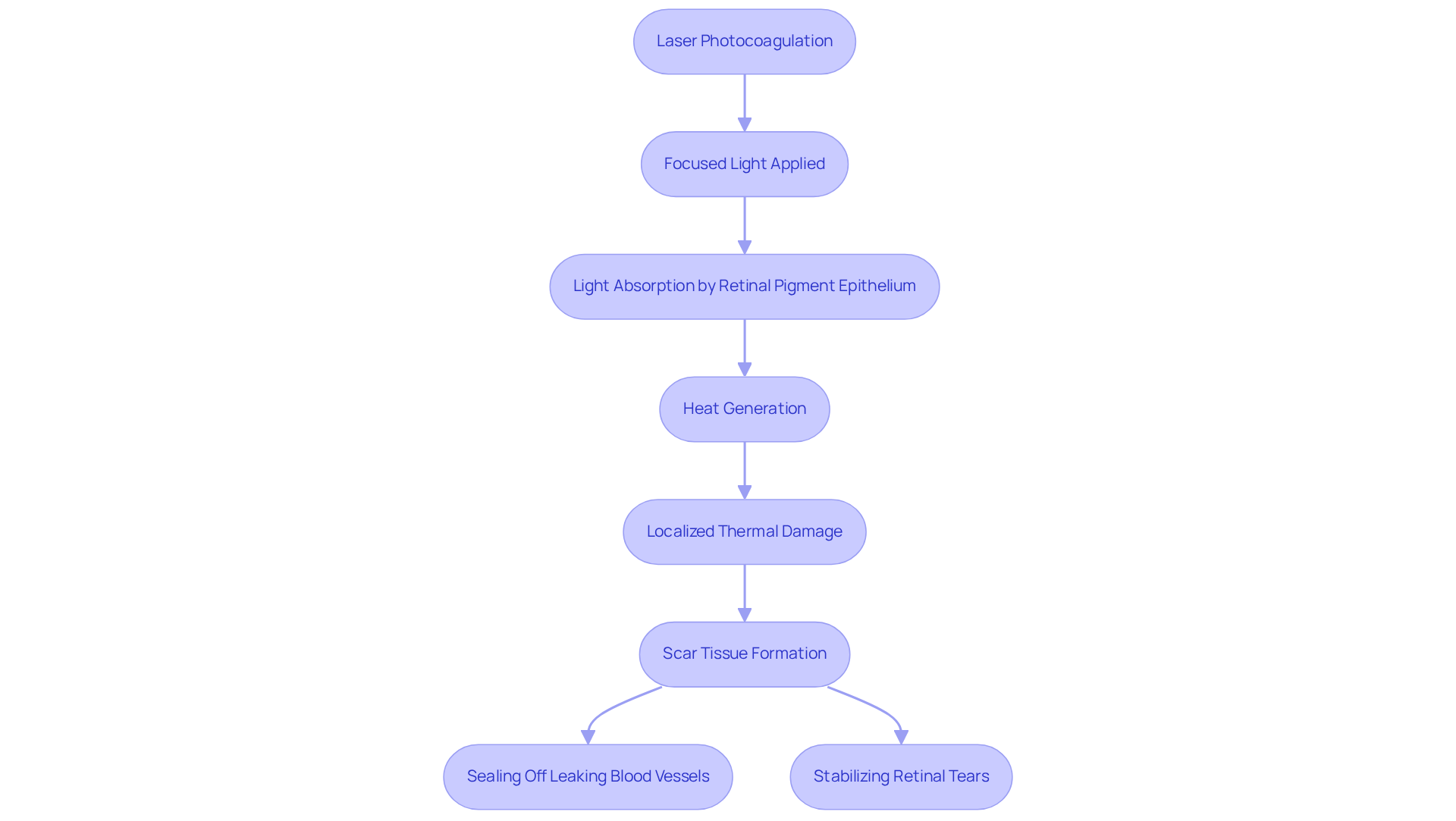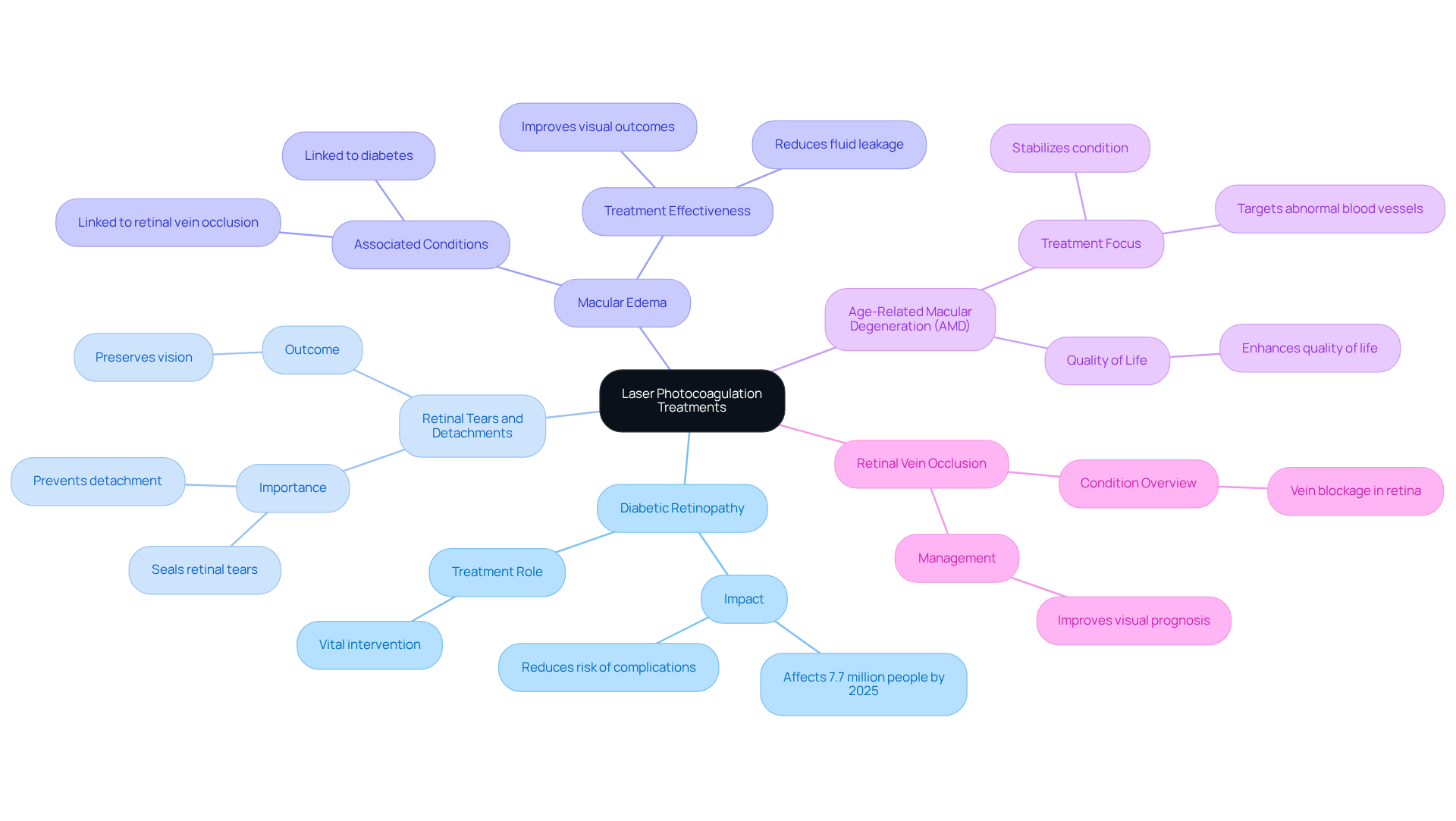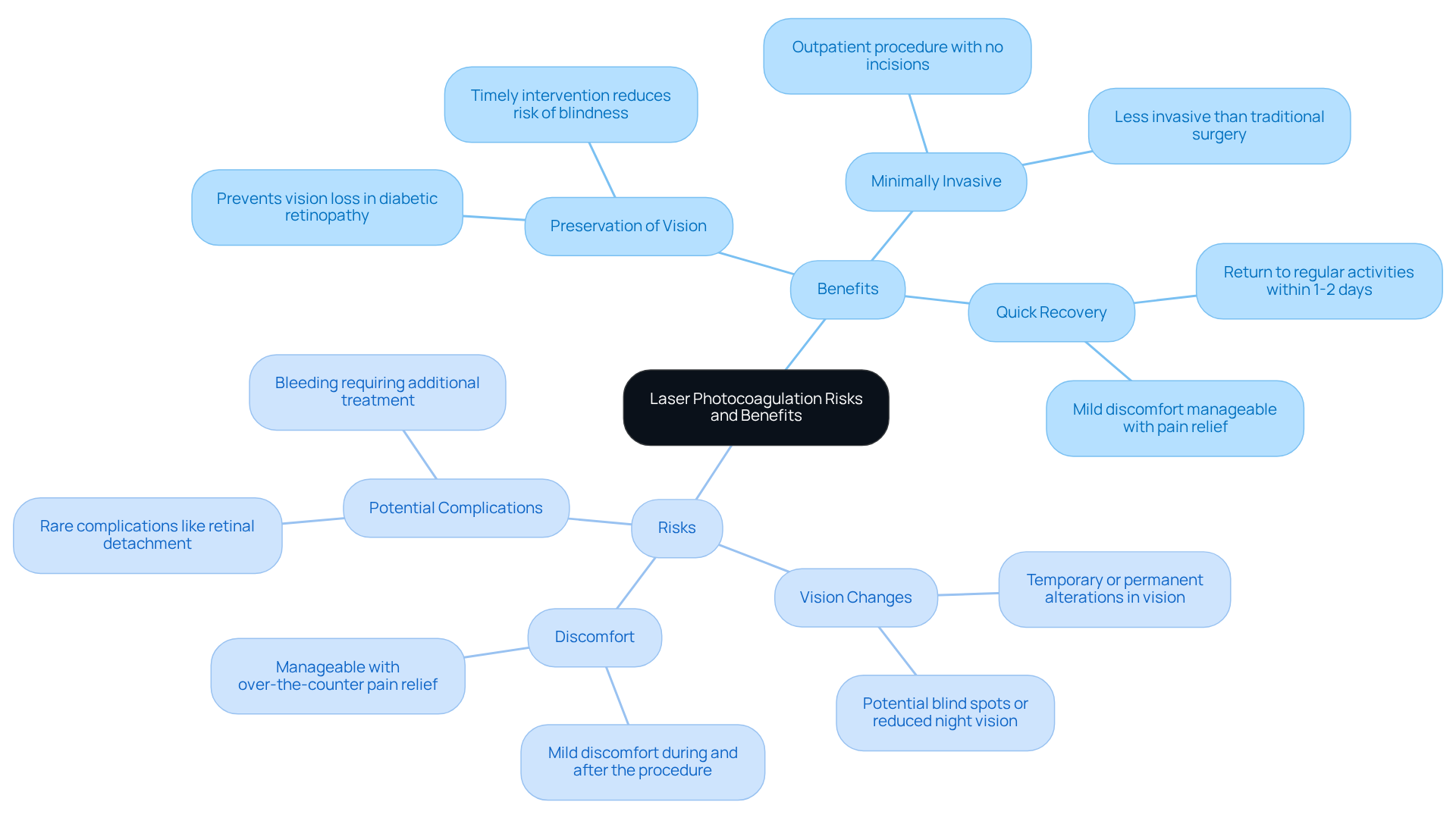Posted by: Northwest Eye in Cataract Surgery, Cataracts on November 4, 2025
Overview
We understand that facing cataract surgery can be daunting, and you may have concerns about your vision and overall eye health. Laser photocoagulation is a critical procedure for cataract patients, as it plays a vital role in preventing vision loss by addressing various retinal conditions, such as diabetic retinopathy and retinal tears.
This minimally invasive treatment utilizes focused light to create controlled burns that stabilize the retina. By doing so, it significantly reduces the risk of severe sight impairment. We want you to feel reassured knowing that advancements in technology have enhanced the safety and effectiveness of this procedure.
It’s common to feel anxious about medical procedures, but remember, you are not alone. Many patients have successfully undergone laser photocoagulation and have shared their positive experiences. They often express relief at how manageable the process was and how it helped preserve their vision.
As you consider this treatment, know that we are here to help you through this process. Your comfort and well-being are our top priorities, and we encourage you to reach out with any questions or concerns you may have. Together, we can navigate this journey towards better eye health.
Introduction
Understanding the complexities of laser photocoagulation is crucial for cataract patients as they explore their treatment options. We recognize that this advanced technique can feel overwhelming, yet it addresses various retinal conditions and plays a vital role in preserving vision and preventing further complications.
It’s common to feel apprehensive about undergoing such a procedure. Questions about safety, effectiveness, and potential risks often arise. What should you truly expect from laser photocoagulation? How can you ensure that you’re making informed decisions about your eye health?
We are here to help you through this process, providing the information you need to feel confident in your choices.
Define Laser Photocoagulation: Principles and Mechanism
The procedure known as photocoagulation is a precise medical technique that employs focused light to produce controlled burns in specific areas of the retina. We understand that the thought of any medical procedure can be daunting, but this technique is designed to help protect your vision. It works on the principle of light energy absorption by the retinal pigment epithelium, which generates heat. This localized thermal damage leads to the formation of scar tissue, which is crucial for sealing off leaking blood vessels and stabilizing retinal tears, ultimately preventing further vision loss.
The advanced accuracy of light-based technology allows for targeted interventions, significantly reducing harm to surrounding healthy tissues while effectively addressing various pathological conditions. However, it’s common to feel concerned about potential risks. While light coagulation treatment is generally safe, complications can include:
- Corneal scarring
- Retinal hemorrhage
- Corneal perforation
That’s why informed consent is essential before the procedure, ensuring you are fully aware of both the benefits and risks involved.
Recent advancements in photocoagulation technology have further improved its effectiveness and safety. For instance, new retinal light therapy systems are designed to minimize side effects while enhancing treatment results for conditions like diabetic retinopathy. Research indicates that light-based coagulation can reduce the likelihood of significant sight loss by more than 50% within a year, highlighting its efficacy in maintaining eyesight. It’s important to note that repeated treatments are often necessary for effective results, as recent studies have shown.
The positive impact of laser photocoagulation is illustrated through its real-world applications in clinical settings. In cases of proliferative diabetic retinopathy, for example, the photocoagulation procedure has been shown to stabilize or even enhance vision in individuals. This underscores its essential role in addressing a primary cause of blindness among working-age adults. Many specialists emphasize that the treatment is relatively painless and usually lasts under thirty minutes, making it a feasible option for many.
Overall, the principles of laser therapy highlight its importance in retinal treatment. By combining advanced technology with targeted therapeutic approaches, we aim to enhance patient outcomes. Remember, we are here to help you through this process, and your vision is our priority.

Identify Conditions Treated by Laser Photocoagulation
Laser photocoagulation is an essential therapy for various retinal conditions, effectively addressing issues that can result in significant sight impairment. We understand that facing these challenges can be daunting, but knowing the options available can provide reassurance. Here are some key conditions treated with this important procedure:
-
Diabetic Retinopathy: This condition affects millions in the U.S. and results from damage to retinal blood vessels due to diabetes, potentially leading to severe vision loss. In 2025, it’s estimated that around 7.7 million people will be impacted. Laser treatment plays a vital role in reducing the risk of complications, making it a crucial intervention for those affected.
-
Retinal Tears and Detachments: This procedure is critical for sealing retinal tears, preventing detachment, and preserving vision. We know that prompt treatment with a focused beam can make all the difference between maintaining your sight and facing irreversible harm.
-
Macular Edema: Often linked to diabetes or retinal vein occlusion, macular edema involves swelling in the macula. Laser treatment effectively reduces fluid leakage and swelling, leading to improved visual outcomes for patients.
-
Age-Related Macular Degeneration (AMD): In certain cases of AMD, the procedure of photocoagulation targets abnormal blood vessels that threaten central vision, helping to stabilize the condition and enhance quality of life.
-
Retinal Vein Occlusion: This condition occurs when a vein in the retina is blocked, resulting in vision complications. Laser treatment can help manage these issues, improving visual prognosis.
Recent studies show that advancements in light technology, such as low-intensity photo stimulation (LIPS) and the modified ETDRS treatment pattern, offer effective treatment options with fewer side effects compared to traditional methods. The Navilas system, which uses retinal eye-tracking technology, allows for more precise beam delivery, minimizing potential harm to surrounding tissues. Retinal experts emphasize the importance of these innovative methods, noting that they can achieve results similar to traditional light therapy without causing tissue damage.
As the prevalence of diabetic retinopathy continues to rise, understanding the role of laser treatment becomes increasingly vital for those looking to preserve their eyesight. Remember, we are here to help you through this process, providing support and guidance every step of the way.

Explain the Photocoagulation Procedure: Steps and Expectations
We understand that preparing for a medical procedure can be a bit overwhelming. Here’s what you can expect during the photocoagulation procedure, step by step:
-
Pre-Procedure Preparation: You’ll receive clear instructions on how to prepare for your procedure. This may include avoiding certain medications and arranging for someone to drive you home afterward.
-
Anesthesia: To ensure your comfort, anesthetic eye drops will be administered before the procedure begins. This will numb your eye, allowing you to feel at ease during treatment.
-
Pupil Dilation: Special drops will be used to dilate your pupil, which helps the surgeon see your retina more clearly. It’s common to feel a bit of pressure during this step.
-
The surgeon will then use a specialized laser device for photocoagulation to focus the laser beam on the targeted area of your retina. The entire procedure typically lasts about 15 to 30 minutes.
-
Post-Procedure Care: After the treatment, you might experience slight discomfort or blurry vision. This is normal, and follow-up appointments will be scheduled to monitor your recovery and assess how well the treatment worked.
-
Recovery Expectations: Most people can return to their regular activities soon after the procedure. However, it’s important to avoid strenuous tasks and follow any specific post-operative care guidelines provided by your surgeon.
We are here to help you through this process, and we encourage you to reach out with any questions or concerns you may have. Remember, you’re not alone in this journey.

Evaluate Risks and Benefits of Laser Photocoagulation
Photocoagulation using lasers offers many benefits for individuals, especially in maintaining sight and addressing eye issues. We understand that considering such procedures can be daunting, but knowing the advantages can help ease your concerns. Here are some key benefits:
- Preservation of Vision: This procedure is crucial for preventing vision loss in patients suffering from conditions like diabetic retinopathy and retinal tears. Studies indicate that timely intervention can significantly reduce the risk of permanent vision loss, as untreated diabetic retinopathy can lead to permanent blindness.
- Minimally Invasive: Conducted on an outpatient basis, photocoagulation using lasers requires no incisions, making it a less invasive option compared to traditional surgical methods.
- Quick Recovery: Most individuals can return to regular activities within a day or two. Many report only mild discomfort during the procedure, which may involve slight pin prick sensations and heightened sensitivity.
While these benefits are encouraging, it’s important to be aware of the associated risks:
- Vision Changes: Temporary or permanent alterations in vision, including blind spots or reduced night vision, may occur. While these changes can be concerning, they are often less severe than the vision loss caused by untreated conditions.
- Discomfort: Mild discomfort is common during and after the procedure, but it is typically manageable with over-the-counter pain relief.
- Potential Complications: Although rare, complications such as retinal detachment or bleeding can arise, which may require additional treatment. Laser treatment is particularly effective in the early stages of diabetic retinopathy, where it is necessary to address leaking blood and fluid from new abnormal blood vessels.
We encourage you to engage in thorough discussions with your ophthalmologist regarding these risks and benefits. It’s common to feel uncertain, but addressing potential risks and complications can help determine if photocoagulation with laser technology aligns with your specific eye care needs. Additionally, follow-up appointments may be necessary to monitor recovery and ensure optimal outcomes. Remember, we are here to help you through this process.

Conclusion
Understanding the complexities of laser photocoagulation is crucial for cataract patients who want to preserve their vision. This advanced technique not only addresses various retinal conditions but also plays a vital role in preventing further vision loss. With its ability to create targeted thermal damage that stabilizes the retina, photocoagulation stands out as an essential tool in modern ophthalmology.
We understand that navigating eye health can be overwhelming. This article explores the principles behind photocoagulation, shedding light on its mechanism, the conditions it treats, and the step-by-step procedure you can expect. Key conditions such as diabetic retinopathy, retinal tears, and macular edema are effectively managed through this minimally invasive approach.
Moreover, discussing the risks versus benefits provides a balanced perspective, empowering you to make informed decisions about your eye health. It’s common to feel uncertain, but knowing the facts can help ease your concerns.
Ultimately, embracing advancements in laser photocoagulation can significantly enhance your quality of life if you’re facing vision challenges. By understanding the procedure and its implications, you can take proactive steps toward maintaining your eyesight. Engaging in open conversations with your healthcare provider about the potential of photocoagulation can lead to better outcomes and a clearer path forward in your journey of eye care.
Remember, we are here to help you through this process. Your vision matters, and together, we can navigate the best options for your eye health.






